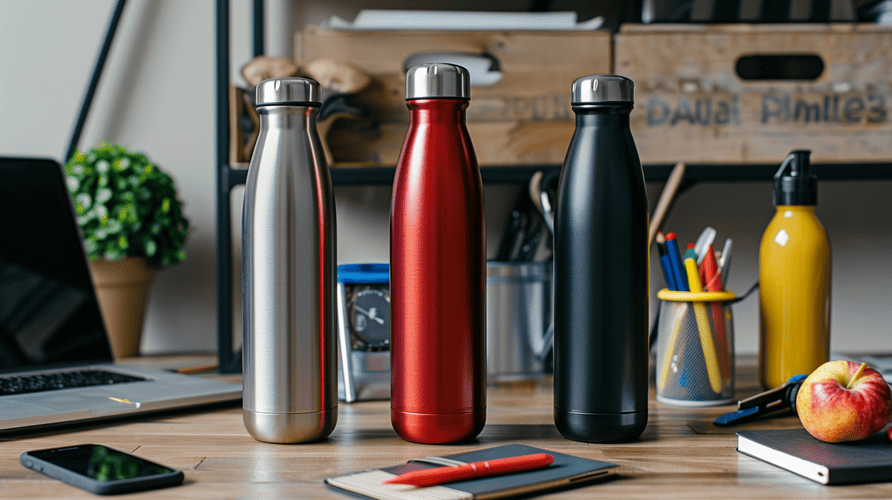Tired of lukewarm water on a hot day? You need a bottle that truly keeps your drink refreshingly cold.
Yes, many stainless steel water bottles are excellent at keeping drinks cold. The key is their construction, specifically if they are double-wall vacuum insulated. This design significantly reduces heat transfer, keeping your drink cold for hours.

I've learned a lot about water bottles over the years, especially as a B2B supplier. My customers, like Mark Shenng from Canada, need to know they're getting a quality product that performs as promised. Understanding how these bottles work is key to providing that assurance and helping them, in turn, satisfy their own customers. Let's explore this further.
Does water stay cold in a stainless steel bottle?
Frustrated when your icy drink turns tepid too quickly? There's a reason why some stainless steel bottles excel while others disappoint.
If it's a double-wall vacuum insulated stainless steel bottle, then yes, water will stay cold. This type of construction creates a vacuum between two layers of steel, which acts as a barrier to heat transfer. This is crucial for maintaining the cold temperature of your drink.

For my business, Icobottle, providing top-quality, custom-logo stainless steel water bottles to clients in America and Europe is my priority. Mark, one of my clients, is a company owner who purchases stainless steel water bottles to rebrand and sell in Canada. He's very sensitive to quality. He needs to know that the bottles he buys will perform. The difference between a single-wall and a double-wall vacuum insulated1 bottle is a critical piece of information for him, and for any procurement officer or startup boss looking for reliable drinkware. A single-wall bottle simply won't offer the same level of temperature retention. Think of it this way: a single layer of steel offers minimal protection against the ambient temperature. Cold drinks will warm up, and the bottle might even "sweat" due to condensation. This isn't ideal for anyone, especially not for a business building its brand on quality.
The Science of Cool: How Double-Wall Vacuum Insulation Works
So, what's the magic behind a bottle that keeps your water cold for hours? It’s all about minimizing heat transfer. Heat can move in three ways: conduction, convection, and radiation.
- Conduction is heat transfer through direct contact. Think of a metal spoon heating up in a hot cup of tea.
- Convection is heat transfer through the movement of liquids or gases. This is like warm air rising from a heater.
- Radiation is heat transfer through electromagnetic waves, like the warmth you feel from the sun.
A double-wall vacuum insulated bottle tackles all three. The two walls of stainless steel reduce heat transfer2 by conduction. The vacuum between these walls is the real star. Since a vacuum is an area with very few air molecules, it dramatically reduces heat transfer by convection because there's little to no medium for the heat to travel through. Some bottles even have a copper layer on the inner wall in the vacuum space to further reduce radiation heat transfer.
For someone like Mark, who lacks deep technical expertise but understands sales, explaining this in simple terms is important. He needs to be confident that the bottles he's sourcing from developing countries like China and Vietnam are genuinely effective. The "double-wall vacuum insulation" is the key phrase he needs to look for and the feature his customers will appreciate.
| Heat Transfer Type | How Double-Wall Vacuum Insulation Mitigates It |
|---|---|
| Conduction | The two separate walls of steel slow down direct heat transfer. |
| Convection | The vacuum between the walls removes most air molecules, preventing heat transfer through fluid movement. |
| Radiation | Reflective properties of stainless steel, and sometimes an added copper layer, reduce heat transfer by radiation. |
Understanding this helps B2B buyers like Mark make informed decisions and ensures they're investing in a product that delivers on its promise of cold drinks.
How long does stainless steel keep drinks cold?
Worried your drink won't last the day? The duration of coldness in a stainless steel bottle isn't just a simple number.
A high-quality double-wall vacuum insulated stainless steel bottle3 can keep drinks cold for 12 to 24 hours, sometimes even longer. However, several factors influence this, including the initial temperature of the liquid, the ambient temperature, and, critically, the lid design.

When I discuss product specifications with clients like Mark, who are focused on both quality and competitive pricing, these details matter. He needs to manage his customers' expectations. A bottle's performance isn't just about the vacuum insulation; the lid plays a huge role. A poorly sealed or non-insulated lid can be a major point of heat loss, or gain in the case of cold drinks. If the lid doesn't create an airtight seal, the vacuum's effectiveness is compromised. Think of it like leaving a window open in an air-conditioned room.
Factors Influencing Cold Retention
Several variables can affect how long your stainless steel bottle keeps your beverage chilled. Understanding these can help you maximize its performance and allows me to guide my clients better.
- Initial Liquid Temperature: Starting with a very cold drink, perhaps even with ice, will naturally mean it stays colder for longer. Adding ice cubes is a common way to extend the cold time.
- Ambient Temperature: If you leave your bottle in a hot car, it will have to work harder to maintain the cold temperature compared to being in an air-conditioned office.
- Lid Design and Seal: This is a big one. The lid must be well-insulated and create a perfect seal. Any gaps or poor insulation in the lid will allow the outside temperature to affect the contents more quickly.
- How Often You Open It: Every time you open the bottle, you allow some heat exchange. The less you open it, the longer it will maintain its temperature.
- Bottle Size/Volume: Larger bottles with more liquid volume may maintain their temperature for longer than smaller ones, assuming all other factors are equal, simply because there's more thermal mass. However, some sources suggest smaller bottles might have better insulation performance due to reduced surface area for heat transfer. It likely depends on the specific design and quality.
- Pre-Chilling the Bottle: Rinsing the bottle with cold water before filling it can help lower its internal temperature, giving your cold drink a head start.
For Mark, whose business model involves rebranding and distributing these bottles, being aware of these factors is crucial for quality control and customer education. He needs to ensure the bottles he sources from suppliers, whether in China or Vietnam, have high-quality lids and robust seals. This minimizes one of his pain points: customer complaints about performance.
| Factor | Impact on Cold Retention |
|---|---|
| Initial Temperature | Colder liquid stays cold longer. |
| Ambient Temperature | Hotter surroundings reduce cold time. |
| Lid Design & Seal | Poor seal/insulation drastically reduces performance. |
| Frequency of Opening | More openings mean faster temperature change. |
| Bottle Volume | Larger volumes may hold temperature longer. |
| Pre-Chilling | Lowers initial bottle temp, helps maintain cold. |
Why does my stainless steel water bottle not keep water cold?
Is your stainless steel bottle failing to keep drinks cold? This common frustration usually points to one of a few key issues.
The most likely reason is that it's a single-wall stainless steel bottle. These offer very little insulation. If it's a double-wall bottle that's not performing, the vacuum seal might be compromised or the lid isn't sealing properly.

This is a critical distinction for my clients. When Mark is sourcing bottles, he needs to ensure he's getting what he pays for. A damaged or defective double-wall bottle is no better than a single-wall one for temperature retention. This directly impacts his business, as inefficient communication with suppliers or receiving faulty products can lead to missed sales seasons – a major pain point for him. Quality inspection, certification, and clear communication are vital.
Troubleshooting Your Chilling Woes
If your once-reliable insulated bottle seems to have lost its touch, or a new one isn't performing up to par, here's what might be happening:
- Single-Wall Construction: As I've mentioned, this is the most common reason. Single-wall bottles are just a single layer of steel and don't have the vacuum insulation needed to keep drinks cold for extended periods. They will feel cold to the touch when filled with cold liquid and may "sweat."
- Compromised Vacuum Seal: This is the Achilles' heel of a double-wall bottle. If the bottle is dropped or dented significantly, the two walls can touch, or the seal that maintains the vacuum can be broken. Once the vacuum is lost, the insulating properties are gone. Sometimes, a manufacturing defect can also be the cause, such as poor welding of the getter (a component that helps maintain the vacuum). You might even hear a rattling sound if a part inside, like the getter, has come loose due to a failed weld, indicating a loss of vacuum.
- Lid Issues: The lid is just as important as the bottle's body. If the lid isn't insulated, if the seal (often a silicone gasket) is damaged, missing, or not fitting correctly, or if the lid is simply not screwed on tightly, cold air will escape, and warm air will enter.
- Wear and Tear Over Time: While stainless steel is durable, seals can degrade, or damage can occur over many years of use, affecting insulation.
Mark understands sales but not necessarily the deep technical aspects. So, when he's doing quality inspections, or if his customers report issues, knowing these potential failure points is essential. For instance, if a bottle is hot or cold to the touch on the outside, or if there's condensation, it's a clear sign the insulation isn't working. This could be due to a broken vacuum seal. He needs reliable suppliers who have robust quality control to avoid certificate fraud or shipping products with compromised vacuum seals. My role at Icobottle is to be that reliable partner, ensuring every bottle, customized with logo and color, meets top-quality standards.
| Issue | Symptoms | Solution/Explanation |
|---|---|---|
| Single-Wall Bottle | Feels cold with cold liquids, "sweats," doesn't keep cold long. | This is expected behavior; it lacks vacuum insulation. |
| Compromised Vacuum Seal | Bottle feels warm/cold on outside, condensation, no longer insulates. | Often due to damage (dents) or manufacturing defect. The bottle likely needs replacement. |
| Lid Problem | Leaking, doesn't seal tightly, drink warms quickly. | Check gasket, ensure lid is on tight. If damaged, replace lid or bottle. |
| Manufacturing Defect | Poor insulation from the start, rattling sound. | Getter may be loose, indicating vacuum failure. Contact supplier for replacement if under warranty. |
Conclusion
Yes, double-wall vacuum insulated stainless steel bottles effectively keep drinks cold for hours. Understanding the difference between single and double-wall construction is key for satisfaction.
-
Explore this link to understand how double-wall vacuum insulation keeps drinks cold, ensuring you choose the best bottles for your needs. ↩
-
Understanding heat transfer is crucial for selecting effective drinkware; this resource will clarify its impact on temperature maintenance. ↩
-
Explore this link to understand the technology behind double-wall vacuum insulation and how it keeps drinks cold longer. ↩

